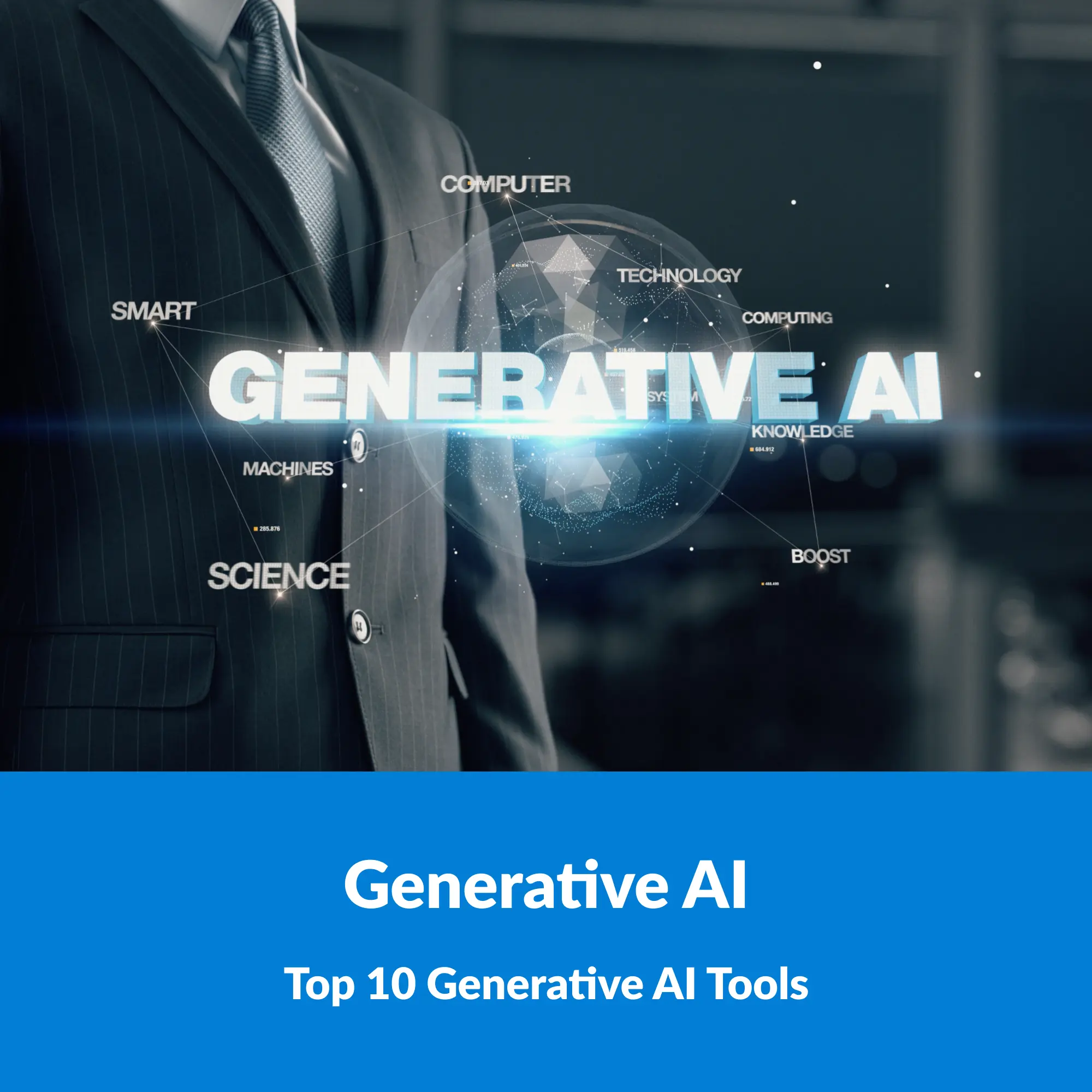In the rapidly evolving landscape of artificial intelligence, generative AI tools have emerged as groundbreaking technologies, reshaping how we approach creativity, problem-solving, and efficiency in various industries. This article presents a detailed look at the top 10 generative AI tools, highlighting their unique features, use cases, and their transformative impact.
What is Generative AI?
Generative AI encompasses algorithms capable of creating new, original content. This technology transcends traditional AI capabilities, venturing into realms of creativity and innovation. It finds applications in diverse areas, ranging from text and image generation to code writing and beyond, offering a glimpse into the future of AI-driven creativity.
Creativity through Various Types of Generative AI

Generative AI technologies are revolutionizing creativity across multiple domains. Let’s delve into how these technologies are fostering innovation in fields like text generation, image creation, music composition, video production, code generation, and 3D object design.
| Text Generation | Text generation AI has significantly evolved, showcasing its prowess in creating poems, scripts, emails, and computer code. Initially, traditional Recurrent Neural Networks (RNNs) were used, but advancements led to more sophisticated models like Long Short-Term Memory (LSTM) and Gated Recurrent Units (GRU), which can understand and utilize long-range dependencies in text. The real breakthrough came with Transformer-based architectures like GPT and BERT. These models are context-aware and generate high-quality textual content, making them invaluable in diverse applications, from creative writing to technical documentation. |
| Image Generation | In the realm of image generation, AI technologies are capable of producing a wide range of visual content, including digital paintings, illustrations, and realistic photographs. The core of these technologies lies in Generative Adversarial Networks (GANs) and Variational Autoencoders (VAEs). These models excel in creating visually appealing and novel images, pushing the boundaries of digital art and graphic design. They have applications in industries ranging from entertainment to advertising, offering unique ways to visualize ideas and concepts. |
| Code Generation | AI tools in code generation assist programmers by generating code snippets or entire scripts in various programming languages like Python and JavaScript. These tools use neural code generation models and techniques like code summarization to automate and enhance software development processes. They improve coding efficiency, reduce the likelihood of errors, and help developers focus on more complex and creative aspects of programming. |
| Music Generation | AI in music generation can compose new pieces across various styles and genres. These systems employ deep recurrent neural networks and reinforcement learning to create compositions that can rival those created by human musicians. From generating melodies and harmonies to complete orchestral compositions, these AI models are transforming the music industry, offering new tools for composers and artists to explore uncharted musical landscapes. |
| Video Generation | Video generation AI acts as a virtual director, creating new content for movies, TV shows, animations, and video games. These sophisticated systems utilize complex neural network architectures and often require extensive datasets of video and audio to produce high-quality results. They are instrumental in reducing production times and costs, offering filmmakers and game developers new avenues for creative storytelling and visual effects. |
| 3D Object Generation | For industries requiring innovative 3D object designs, such as furniture, vehicles, or architectural structures, generative AI provides cutting-edge solutions. Leveraging technologies like 3D Generative Adversarial Networks (3D-GANs) and variational autoencoders (VAEs), these systems design and produce 3D models with high precision and creativity. They are reshaping fields like architecture, product design, and virtual reality, enabling the creation of complex and intricate 3D objects that were previously challenging or time-consuming to design. |
Top 10 generative AI tools
Let’s explore the top 10 generative AI tools and platforms that are shaping the present and future of technology:

1. Chat GPT 3.0 – Chat GPT 4.0: ChatGPT, developed by OpenAI, is a powerful language model known for its ability to generate human-like text. It assists in content creation, customer service, and language translation. ChatGPT 4.0, the latest version, offers enhanced accuracy and more nuanced responses.
- Key Features: Advanced language processing, context understanding, conversation continuity.
- Use Cases: Content creation, customer support, data analysis, language translation.

2. Bard & Gemini: It’s a conversational AI tool designed to provide information and insights, potentially revolutionizing search and information processing.
Recently, Google showcased a groundbreaking demonstration of Bard’s advanced capabilities, highlighting its transition into Gemini. This latest iteration marks a significant leap in AI technology, being multi-modal in nature. Gemini can not only process and generate text but also has the ability to understand and create visual content, integrating images and videos. This multi-modal aspect allows for a more holistic approach to information processing and content creation.
- Key Features of the Latest Demo:
Multi-Modal Interaction: Gemini can interpret and generate both text and visual content, allowing for more dynamic and engaging information presentation. Enhanced Creativity and Understanding: The tool’s ability to process visual elements alongside text enables it to provide more comprehensive answers and create richer content.
Seamless Integration with Google’s Ecosystem: As part of Google’s suite, Gemini leverages the company’s extensive databases and search capabilities, providing users with highly accurate and diverse information.
- Use Cases Enhanced by Multi-Modality:
Visual Content Creation: Gemini can assist in creating complex graphical representations, infographics, and even assist in artistic endeavors.
Educational Purposes: Its ability to explain concepts using both text and visuals makes it an invaluable tool for learning and teaching.
Research and Data Presentation: Gemini can aid in the visualization of data, making research findings more accessible and understandable.”

3. AlphaCode: Developed by DeepMind, AlphaCode specializes in writing computer programs at a competitive level. It’s a breakthrough in AI-assisted coding, aiding developers in software engineering and problem-solving tasks.
- Key Features: Code generation, problem-solving in programming contests.
- Use Cases: Software development, educational purposes, coding competitions.

4. GitHub Copilot: GitHub Copilot, powered by OpenAI’s Codex, is an AI pair programmer that assists developers by suggesting whole lines or blocks of code, significantly speeding up the development process.
- Key Features: Code suggestions, language versatility, integration with popular IDEs.
- Use Cases: Software development, code debugging, learning programming.

5. Copy.ai: Copy.ai is a versatile AI-powered tool that streamlines content creation. Its key features include AI-generated text for various purposes, such as blog posts, ad copy, social media captions, and more. With Copy.ai, users can save time and effort by generating high-quality content with just a few clicks.
- Key Features: generate text for a wide range of content types, including articles, ads, emails, and more, produce content rapidly, User-Friendly Interface, Customization tone, style, and other parameters
- Use Cases: use for marketing (compelling product descriptions, create persuasive ad copy, social media posts), content creation (generate blog post outlines, headlines, and even entire articles), email marketing, SEO optimization, social media, Product Description, Business Communications.

6. Cohere Generate: Cohere Generate is a natural language processing tool that excels in generating, modifying, and understanding human language, enhancing content creation and language models.
- Key Features: Natural language understanding, text generation, scalability.
- Use Cases: Content creation, chatbots, language models.

7. DALL-E 2: Developed by OpenAI, DALL-E 2 is an AI program capable of creating realistic images and art from textual descriptions. It’s a pioneering tool in AI-driven creativity and design.
- Key Features: High-quality image generation, creative design options.
- Use Cases: Artistic creation, design prototyping, educational content.

8. AI-Writer: AI-Writer is a content generation tool adept at creating SEO-optimized articles, blogs, and reports, making it a valuable asset for content marketers and writers.
- Key Features: SEO-optimized content, research-based article writing.
- Use Cases: Blogging, report generation, content marketing.

9. Midjourney: Midjourney is an independent research lab’s generative AI tool focused on creative visualizations and design, aiding artists and designers in their creative processes.
- Key Features: Unique visual content creation, artistic exploration.
- Use Cases: Graphic design, concept art, creative brainstorming.

10. Claude: Claude is an AI tool designed for effective and efficient communication. It aids in writing, summarizing, and translating text, streamlining communication across various platforms.
- Key Features: Advanced language understanding, Multilingual translation, Efficient text summarization, Contextual content generation, Real-time translation capabilities, Customizable tone and style, Broad platform integration.
- Use Cases: Professional and business communications, Enhanced customer support, Content marketing and creation, Academic research and summarization, Language learning and translation, Social media content management, Legal and medical document assistance.
Generative AI tools are not just futuristic concepts; they are here, profoundly influencing how we work and create. From enhancing productivity to sparking creativity, these tools are indispensable in the modern digital landscape. As AI continues to evolve, we can expect these tools to become even more sophisticated, further transforming our professional and creative endeavors.






